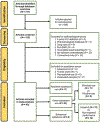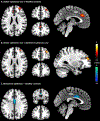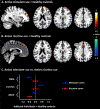Distinct patterns of prefrontal cortical disengagement during inhibitory control in addiction: A meta-analysis based on population characteristics
- PMID: 33933507
- PMCID: PMC8411123
- DOI: 10.1016/j.neubiorev.2021.04.028
Distinct patterns of prefrontal cortical disengagement during inhibitory control in addiction: A meta-analysis based on population characteristics
Abstract
Prefrontal cortical dysfunctions underlying inhibitory control deficits in addiction are complex and likely dependent on population characteristics. Here, we conducted a meta-analysis to examine alterations in brain activations during response inhibition in addicted individuals. We characterized imaging findings based on substance use status, diagnosis, substance classes, and task performance. Results revealed in those with active drug addiction hypoactivation of the left dorsal anterior cingulate cortex (dACC) and right middle frontal gyrus (MFG), compared with healthy controls. Weakening of the dACC and MFG activations was particularly pronounced in nicotine users, respectively. Impaired task performance was also associated with diminished MFG activation. In contrast, abstinent users did not exhibit any significant differences compared with healthy controls. Those with behavioral addictions were characterized by higher midcingulate cortical activation. Thus, the neural disengagement during response inhibition in active drug addiction was limited to a small number of prefrontal cortical regions and dependent on population characteristics. Finally, the evidence for potential normalization of hypofrontality following substance use cessation highlights the benefits of abstinence in restoring cerebral functions.
Keywords: Behavioral addiction; Drug addiction; Inhibitory control deficits; Meta-analysis; Prefrontal cortex; Response inhibition; fMRI.
Copyright © 2021 Elsevier Ltd. All rights reserved.
Figures




Similar articles
-
The Neural Signature of Impaired Inhibitory Control in Individuals with Heroin Use Disorder.J Neurosci. 2023 Jan 4;43(1):173-182. doi: 10.1523/JNEUROSCI.1237-22.2022. Epub 2022 Nov 17. J Neurosci. 2023. PMID: 36396402 Free PMC article.
-
Altered neural activities during response inhibition in adults with addiction: a voxel-wise meta-analysis.Psychol Med. 2021 Feb;51(3):387-399. doi: 10.1017/S0033291721000362. Epub 2021 Feb 22. Psychol Med. 2021. PMID: 33612127 Review.
-
Impaired functional connectivity within and between frontostriatal circuits and its association with compulsive drug use and trait impulsivity in cocaine addiction.JAMA Psychiatry. 2015 Jun;72(6):584-92. doi: 10.1001/jamapsychiatry.2015.1. JAMA Psychiatry. 2015. PMID: 25853901
-
The role of emotional inhibitory control in specific internet addiction - an fMRI study.Behav Brain Res. 2017 May 1;324:1-14. doi: 10.1016/j.bbr.2017.01.046. Epub 2017 Feb 4. Behav Brain Res. 2017. PMID: 28174031
-
Neuroscience of inhibition for addiction medicine: from prediction of initiation to prediction of relapse.Prog Brain Res. 2016;223:165-88. doi: 10.1016/bs.pbr.2015.07.007. Epub 2015 Oct 21. Prog Brain Res. 2016. PMID: 26806776 Free PMC article. Review.
Cited by
-
Machine Learning Classification of Smoking Behaviours-From Social Environment to the Prefrontal Cortex.Addict Biol. 2025 Aug;30(8):e70056. doi: 10.1111/adb.70056. Addict Biol. 2025. PMID: 40770594 Free PMC article.
-
Slow-Wave EEG Activity Correlates with Impaired Inhibitory Control in Internet Addiction Disorder.Int J Environ Res Public Health. 2022 Feb 25;19(5):2686. doi: 10.3390/ijerph19052686. Int J Environ Res Public Health. 2022. PMID: 35270377 Free PMC article.
-
Atypical local brain connectivity in pediatric autism spectrum disorder? A coordinate-based meta-analysis of regional homogeneity studies.Eur Arch Psychiatry Clin Neurosci. 2024 Feb;274(1):3-18. doi: 10.1007/s00406-022-01541-2. Epub 2023 Jan 4. Eur Arch Psychiatry Clin Neurosci. 2024. PMID: 36599959 Free PMC article.
-
A scoping review of electroencephalographic (EEG) markers for tracking neurophysiological changes and predicting outcomes in substance use disorder treatment.Front Hum Neurosci. 2022 Oct 17;16:995534. doi: 10.3389/fnhum.2022.995534. eCollection 2022. Front Hum Neurosci. 2022. PMID: 36325430 Free PMC article.
-
Inhibitory control in the sober state as a function of alcohol sensitivity: a pilot functional magnetic resonance imaging (fMRI) study.Front Hum Neurosci. 2025 Feb 28;19:1557661. doi: 10.3389/fnhum.2025.1557661. eCollection 2025. Front Hum Neurosci. 2025. PMID: 40092652 Free PMC article.
References
Publication types
MeSH terms
Grants and funding
LinkOut - more resources
Full Text Sources
Other Literature Sources
Medical

